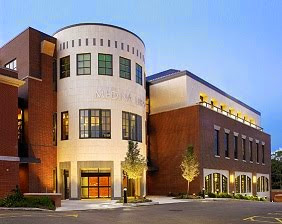Guest Blogger: Lauren Kuntzman, MCDL Family History & Learning Center Manager
In this next installment of our instructional blog posts, we will take a look at church records. This post will focus on the United States -- but many of the research strategies could be applied to your ancestors regardless of the place where they lived or the faiths that they practiced.
Church records aren’t always easy to find. Since the United States has no state church, there is more variation in the records, both in terms of their completeness and how they have been archived, than what is seen in other countries. While more of these records have been digitized in recent years, the vast majority remain held by churches, libraries, historical societies, and archives.
 |
Records from Island Creek Presbyterian Church in Toronto, Ohio.
Records include child's date of birth and parents' names.
Image from Ancestry. |
Despite these challenges, church records are worth the effort to locate. Most frequently, church records include Baptisms (or Christenings), Marriages, and Burials. These records can act as substitutes for civil birth, marriage, and death records -- especially during the years before vital records were kept. Church records can provide evidence of major vital events in one’s life and may help connect children to parents -- and sometimes even their grandparents, too!
Beyond baptisms, marriages, and burials, church records can also include documents when individuals joined or left a church. These documents can help track a family’s migration from one part of a country to another. Other church records include membership lists, financial reports, excommunications, newspapers/newsletters, and more. All of these records have details that can help give you a better understanding of your ancestor’s life.
As author Val D. Greenwood points out, finding church records is a two-step problem. First you need to know which religious denomination your ancestor practiced; then you need to find the records for your ancestor’s church.
 |
Medina Sentinel. May 4, 1905.
Page 5. Obituary notes that Spellman
belonged to the Methodist
Episcopal Church. |
To determine which church your ancestor attended, try the following tips:
- Read your ancestor’s obituary - it may list a church where their funeral services were held and/or name a member of the clergy conducting the service.
- If your ancestor is buried in a cemetery, consider if the burial ground had a religious affiliation. (This could be the cemetery in its entirety, or the specific section in which your ancestor is buried.)
- Look at maps. Which churches are closest to your relatives’ home?
- Consider you or your parents’ religious denomination. Has this been passed down through your family?
Once you’ve determined which church your ancestor attended, it’s time to try to locate their records. According to the FamilySearch Wiki article on "United States Church Records," there are over 25 major religious denominations practiced in the USA (see the full list
here). Since there is no way to cover all of these religions in-depth in a single blog post, here are some strategies for research that can be applied to any religion:
- Start local. Does the church still exist today? (If it doesn’t, has it merged with another local congregation?) Review the website, locate the church’s contact info, and reach out to their staff to ask if records still exist.
- In the geographic area of the church, check with a local public library, genealogical/historical society, and/or university library/archive. Ask questions of the staff and search their collections. Here are just a few of the archives in Ohio that have significant collections of church records:
- Search ArchiveGrid. This resource can help point you to archival collections held around the world. (The search terms of Ohio “Church Records” returned over 300 results. Use a denomination as a search term, too.)
- Search the FamilySearch Catalog by place and the subject “church records.”
- Search Ancestry’s “Card Catalog” using your ancestor’s religious denomination.
- If you have ancestors who were Roman Catholic, search FindMyPast’s “Catholic Heritage Archive,” the most comprehensive online collection of Roman Catholic records for Britain, Ireland and North America. You can access this resource at Akron-Summit County Public Library.
If you still aren’t having luck finding your church records, connect with others and ask for help. You can do this…
- online through social media/message boards
- in-person at genealogy conferences
- Note: Later this month, Cleveland will host the International Conference on Jewish Genealogy. This conference is a great resource for anyone with Jewish ancestors. Learn more at https://www.iajgs2019.org/index.cfm.
- at your local library -- you can always reach out to the MCDL Genealogy Team for help! Contact us at me-team.genealogy@mcdl.info.
When you find records for your ancestor’s church, here are a few tips to make the most of what you find:
- Cite your source and analyze it. Note the repository who holds the records (library, church, etc.), as well as details about the particular set of records you’re searching. Make notes about the following topics: What time period does the records cover? Can you tell who the author was? How are the records arranged - by record type or chronologically?
- If it is a bound volume, check the front/back of the book for an index.
- Even if there is an index, browse other pages of the book. (You might find other relatives!) This is especially true with online records, many of which aren’t completely (or accurately) indexed.
- Be prepared, that depending on the denomination and your ancestor’s ethnicity, some of the records might not be in English. FamilySearch’s Wiki offers great word lists that can help with reading these records. (Here’s a link to their Latin Word List as an example.)
Want to learn more? Here are a few resources that were used in writing this article:















